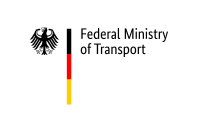Older news
The German flag is always available for you - on 365 days of the year. You can reach our specialists under the phone number +49 3190-7777 for all questions about maritime shipping under German flag
The maritime 24/7 hotline is offered by the Federal Maritime and Hydrographic Agency, BSH. In addition, the stand-by service of the Ship Safety Division of BG Verkehr is also available. More information is given under "Contact Details".
A medical emergency at sea – no rescue service, no hospital, no doctors. It is the master's or navigational officer's obligation to help. The newly published handbook can help to facilitate the best medical care possible in places far away from medical infrastructure.
This book from practitioners for practitioners offers compact treatment recommendations for emergencies, injuries and illnesses on board sea-going vessels.
350 illustrations and texts that are illustrative, easy to understand and, above all, aimed for application during sea voyages support medical care on board.
As a special service, educational films showing step-by-step sequences of complex treatment measures can be watched with QR Codes.
The English version of the Maritime Medical Handbook is now available at the price of 159,00 € at:
Dingwort Verlag in Hamburg.
It can also be ordered online via https://dingwort-verlag.de/medizin/.
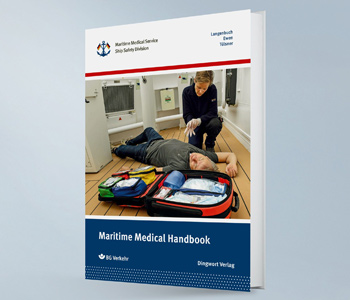
The BG Verkehr, the BSH and the Federal Office for Information Security (BSI) published a circular on protection against maritime cyber risks. The practical guidance called "ISM Cyber Security" contains recommendations for shore-based and ship-based IT protective measures. With its help, shipping companies can improve their protection from cyber risks within the framework of the ISM system.
The issue cyber security becomes increasingly important for maritime shipping as a crucial part of the logistics chain. If not before, than at the latest since the attack with the malware "NotPetya" in 2017 resulting in damages of several hundred million Euros for the shipping company Maersk alone, the extent of maritime cyber attacks has become evident.
With resolution MSC.428(98), the IMO urges shipping companies to protect against cyber risks from 2021. Ship operators should integrate appropriate measures in their existing ISM systems.
The new circular "ISM Cyber Security" by the BG Verkehr, the BSH and the BSI provides an overview of the issue maritime cyber security and aids shipping companies in developing a consistent cyber risk management. As a minimum, the three authorities advise the IT-Grundschutz Profiles by the BSI for shore operations and for ship operations. These model security concepts contain specific recommendations for IT security measures on board and onshore.
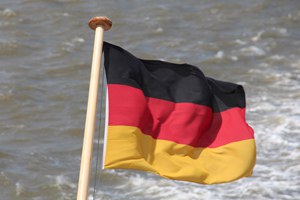
In a new video, the Maritime Medical Service of the BG Verkehr explains how to put on and take off personal protective equipment in the right way. By following the instructions, navigational officers responsible for medical care on board can protect themselves effectively against infectious diseases. The video is now available.
How do you protect yourself when an infectious disease occurs with a person on board? This is not a new question, but the COVID-19 pandemic has raised awareness with seafarers once again. The "Maritime Medical Handbook" by the Maritime Medical Service, which has recently been released, gives clear answers and has now been supplemented with a new video.


The best protection against contagious infections on board is regular washing of the hands, disinfection and wearing personal protective equipment (PPE) such as gloves, an oronasal mask and safety goggles. But even the best protective equipment is only effective if the seafarer puts it on and takes it off in the right way. The new video by the Maritime Medical Service "Putting On and Taking Off Personal Protective Equipment (PPE)" gives advice. The film takes about three minutes and explains, among other things, in which order the protective equipment is to be put on to avoid unwanted infections.
With a QR code or the direct link https://www.medizinisches-handbuch-see.de/Schutzausruestung_en.html, seafarers can watch the video in German or English. The film is part of the "Maritime Medical Handbook", which is an essential practical guide to medical care on board sea-going vessels.
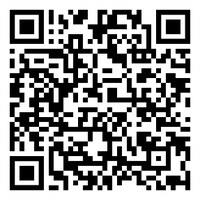
Since the video was developed after the recent version of the medical handbook had been published, the QR code could not be included in it. Users of the handbook should stick the QR code onto the pages 26 and 485. In the English version of the Maritime Medical Handbook, which will be published soon, the QR code will be included.
According to a survey by the German Shipowners' Association (VDR), revenue of member shipping companies have fallen by 40 % due to the Corona Pandemic. The number of ships without engagement is growing. The German Flag has easy regulations regarding laid-up ships.
Some flag states have extensive requirements for laid-up ships, e.g. changes of ship registration or extensive lay-up plans. The German Flag, however, has no such bureaucratic obligations.
Neither do laid-up ships under German flag require a separate Safe Manning Certificate. For short-term shifting of a ship from a port or anchoring place to another location, shipowners can apply for a Safe Manning Certificate that is valid for up to 48 hours with the Ship Safety Division of BG Verkehr. The prerequisites for this are given under our header "Ship`s manning".
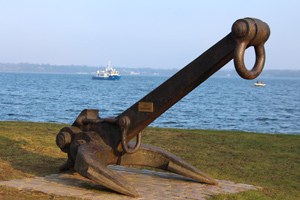
For a long time, asbestos was considered a miracle product: the natural mineral is fire resistant, an insulator, easy to process and inexpensive. But asbestos causes illness and can give rise to cancer. BG Verkehr summarized the things shipping companies have to observe when they flag-in a ship that is contaminated with asbestos.
Those who worked with asbestos in the past often used to breath in the dust and thereby the fine asbestos fibres. A possible result: malignant cancer tumours or changes in the lining of the lung. The employer's liability insurance associations recognize asbestos as a cause of a lung disease known as asbestosis, and as an occupational disease. Asbestosis is the most common cause of death among the terminal occupational diseases. There can be several decades between working with asbestos and the onset of the disease. On average the latency period is 38 years.
Since 1993, asbestos may not be produced or used in Germany, and on a European level since 2005. From 2019 all ships under EU flag from 500 GT must have an inventory of hazardous materials, which must also include asbestos. With the Regulation EU/1257/2013 the EU legally implements the provisions of the Ship Recycling Convention (“Hong Kong Convention”).
Globally, however, there is no ban on asbestos. So, there may still be asbestos present on older ships. If such a ship flags-in under the German flag, the shipowner will have to conduct a risk assessment, compile an asbestos cadaster and arrange mandatory medical check-ups for the seafarers. The prevention division at BG Verkehr has developed a compilation of the shipowner’s obligations when operating an asbestos-contaminated ship.
In addition to this compilation, ship operators have to comply with the provisions of the international SOLAS Convention regarding the ban of asbestos on sea-going vessels. The Circular by the Maritime Safety Committee of the IMO MSC.1/Circ.1374 "Information on prohibiting the use of asbestos on board ships" provides more detailed requirements and information on the topic asbestos on sea-going vessels:
- On ships built before 1 July 2002, asbestos containing materials (ACMs) may be installed and approved as long as they do not pose a risk to the crew's health.
- On ships built on or after 1 July 2002 and before 1 January 2011, new installation of ACMs has been allowed only in exceptional cases.
- On ships built on or after 1 January 2011, ACMs have not been allowed to be installed (refer to SOLAS Chapter II-1/3-5).
The Circular was published in the German "Verkehrsblatt" (transport gazette) 19/2013 on 23 September 2013 in the German language and is mandatory for ships flying the German flag.
Specialists discover asbestos on some sea-going vessels during inspections at a later point in time – for example while compiling an Inventory of Hazardous Materials (IHM) in accordance with EU Regulation 1257/2013 and the Hong Kong Convention on the Recycling of Ships. In these cases, a transitional period of three years applies to carry out an asbestos abatement on board or an exchange of all of the ACMs (refer to Circular MSC.1/Circ.1374). This transitional period of not more than three years cannot be extent, not even if:
- during this time period the ship was temporarily flying a different flag or
- asbestos had already been identified three years prior on a ship that was flying a foreign flag and is now about to change to the German flag.
For questions regarding these requirements, the experts of the Machine Department of the Ship Safety Division of BG Verkehr are gladly of assistance (e-mail maschine@bg-verkehr.de or contact qualified engineer Holger Steinbock via phone: +49 40 361 37-217).
As of late, the Deutsche Seemanns Mission e. V. (DSM – German Seamen's Mission) offers seafarers a new service. With the web-address https://dsm.care, the DSM operates a chat platform on which seafarers can turn to employees of the Seamen's Mission with their issues, worries and distress.
The DSM has a widely spread network with its 16 national and 14 international stations with seamen's clubs, hotels and on-board counsellors. However, the corona pandemic has completely changed the work of the seamen's missions as well. The popular facilities for seafarers had to close and the on-board counselling cannot take place in same manner as it did before either. Long counselling sessions are not possible – because of the fear of infection. Sometimes what remains is a small talk on the gangway so that the connection with the outside world does not completely break off.
In this situation, the DSM has started their chat counselling which can be accessed worldwide via the internet address https://dsm.care. Co-initiator Matthias Ristau, seamen's pastor of the German "Nordkirche", explains: "All encoded and safe, available from early in the morning till late at night". Especially now that many seafarers fear for the well-being of their families, such a service is all the more important, he says.
On the chat platform, seafarers meet professional counsellors, experienced social workers and psycho-social experts of the DSM who are most familiar with the special living situation and working environment of seafarers.
DSM.care was developed by a DSM team and is an additional offer for seafarers under these changing conditions of maritime navigation. This way, seafarers can be provided counselling support during straining situations right there and then and no matter where with the click of a mouse or via the smartphone. The DSM affirms: Even if the internet cannot replace personal contact, the members of staff of the German Seamen's Mission are there for the seafarers as contact partner.
The revised Guideline on Food Hygiene give practical guidance and helpful procedures to make sure food is handled hygienically and safely on board of ships.
A well-balanced and healthy diet is important, especially when working hart. On board ships on weeklong voyages, it is necessary to plan ahead and store and prepare foodstuffs appropriately. That way, what ends up on the plate not only tastes good but is also healthy and wholesome.
The Guidelines on Food Hygiene by the Ship Safety Division of BG Verkehr explain in step with actual practice what is part of hygienic food provision on board. It presents comprehensively what the shipowner, the master and the galley and service personnel can and must do to make sure that the way food is stored and prepared does not pose hazards or health risks. Therefore, the main topics of the guidelines are clean drinking water, correct storage and hygienic preparation, which are key to achieving this.
Photos and illustrations depict how to do it properly and what needs to be avoided. Newly added annexes show how to wash the hands properly and how to keep the galley workplace clean and safe. A useful checklist helps control safe food storage and preparation on a regular basis and self-dependently.

The Ship Safety Division of BG Verkehr has changed their approval practice regarding in-water surveys of German-flagged ships. As of now, the inspection of the ship's bottom can also be done inside the water if a ship does not have an additional class notation for in-water surveys (e.g. "BIS", "IW").
Under the SOLAS Convention (Regulation I/10(a) in part B), two bottom surveys have to be conducted for sea-going vessels within a 5-year period. For cargo ships younger than 15 years, the first survey is not required to be done in drydock but can also be conducted in the water by a diver.
So far, the German Flag demanded an additional class notation (e.g. "BIS", "IW") or appropriate structural conditions for an in-water survey – among other things, fixed markings at the hull below the waterline and safe access to the sea chests, rudder bearings and stuffing boxes for the diver.
Other flag states or classification societies use the current IACS UR Z 3 Rev.7 of January 2018 (the abbreviation "UR" means "Unified Requirements"). The Ship Safety Division also has decided to follow these rules of the International Association of Classification Societies (IACS) for sea-going vessels under German flag from now on.
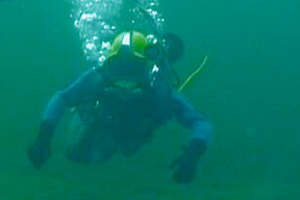
In-water surveys are, inter alia, approved under the following circumstances:
- survey in sheltered water, preferably with weak tidal streams and currents;
- the in-water visibility and the cleanliness of the hull below the waterline are to be good enough to permit a meaningful examination which allows the surveyor and the in-water survey firm to determine the condition of the plating, appendages and the welding;
- the diving survey shall be carried out by a company approved by the competent classification society under the supervision and to the satisfaction of the class surveyor;
- if damages are detected during the in-water survey, the class surveyor may order a drydock bottom survey.
Further details are outlined in:
The new guidelines of the International Transport Workers’ Federation (ITF) and the International Chamber of Shipping (ICS) aims to contribute to better working and living conditions of seafarers. The authors explain the different social aspects for a uniform implementation of the Maritime Labour Convention.
With the Maritime Labour Convention (MLC), the International Labour Organisation ILO laid down binding and worldwide requirements which provide seafarers with the right to appropriate work and life on board sea-going vessels. Now the new Guidelines for implementing the Welfare aspects of the Maritime Labour Convention 2006 follow with practical guidance.
In the guidelines it is described which social support contributes to the welfare of seafarers. The usage of the internet on board as well as in the ports plays an important role in the day-to-day life of seafarers. The protection of underage seafarers and reliable payment of wages - even in the event of illness – are further requirements with direct impact for the seafarers.
For seafarers their ships are not only workplace but for long stretches of time the place where they spent their time off. Seafarers from all around the world work and live together in limited space far from their friends and family. The guidelines explain that this difficult situation can be eased by appropriate accommodation (e.g. good furnishings, ventilation, heating, adequate separation of operational and sleeping areas), compliance with health and safety standards (medical equipment, sanitary facilities, etc.) and regard for personal needs (this also includes spaces for religious activities and recreational facilities and equipment). Other aspects that need to be taken into account are a healthy and balanced diet as well as occupational health and safety.
As seafarers usually spend only a rather short time with their ship in a port, it is crucial that the orientation at these often new and alien places is facilitated. The accessibility of urban facilities such as banks, doctors, advisory or counselling services, shopping places or recreational facilities as well as welfare facilities (e.g. seamen's missions) have proven to be important. Therefore, the member states of the ILO should support financing and organisation of these onshore social facilities.
Germany bindingly joined the Maritime Labour Convention (MLC) in 2013. With the German Maritime Labour Act, the legislator brought into force the provisions of the Convention in German law. For all parties involved in implementing these provisions, the German Flag State Administration also published comprehensive and recently revised Guidelines on the implementation of the Maritime Labour Convention on board of German flagged ships. On the webpages of the section "Crew", there is further information given about this topic.
The Seafarer's Compendium of the BG Verkehr has become a popular standard work for any question regarding safety on board of sea-going vessels. In addition to the hardcopy version, an award-winning digital version for mobile devices is now available.
By now on almost every German sea-going ship, a copy of the compendium "Occupational safety and health protection on board of merchant and fishing vessels" (Handbuch See – Arbeitssicherheit und Gesundheitsschutz in der Seeschifffahrt und Fischerei) can be found. 69 modules illustrate with few words and "talking" pictures to what seafarers have to pay attention in order to neither put themselves or anyone else in danger. During an instruction about certain topics, the corresponding modules can be used as a basis for remarks. This book of reference is now also available as digital version for mobile devices.
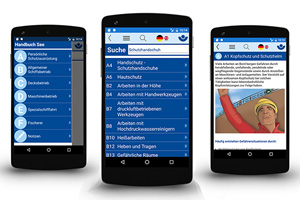
Winner of the "eLearning Award 2018"
The implementation of the well-established compendium electronically is fashioned to serve the particular conditions at of maritime shipping. Independent of time and place and an internet connection, the essential information is available to the user both on- and offline. The user can readily change between German and English. A keyword search makes it easy to quickly find specific contents. As an additional innovation, it is now possible to document and save data like photos and notes, for example about injuries to persons or property damages and near accidents.
These many useful functionalities also managed to impress on the education fair didacta. In the category knowledge management, The BG Verkehr was awarded the "eLearning Award 2018" for their app.
The app is now available for free download in the app stores for Android and iOS operating systems.
Maritime shipping too has to become (even) more environmentally friendly. Therefore, since the beginning of 2018, the EU prescribes that the shipowners have to trace the emissions of their ships. This requirement of the so called MRV Regulation are now supplemented with new rules by the International Maritime Organisation IMO. We explain the differences between the two systems.
The Regulation (EU) 2015/757 on the monitoring of carbon dioxide emissions from maritime transport applies since 2018. This regulation is better known under its abbreviation MRV which stands for monitoring, reporting and verification. Now the IMO has added another system: the Data Collection System (in short: DCS). In this system the fuel consumption of maritime ships is established.
Both procedures resemble one another and shipowners can use some of the collected data for both systems. But there are also differences. For example, in Germany different authorities monitor the compliance of the requirements.
We have compiled the most important differences for you in the following table. Below the table, you will find more detailed information about the two procedures.
| Procedure: | EU MRV Regulation | IMO DCS (Data Collection System) |
|---|---|---|
| Monitoring of: | carbon dioxide emissions | IMO DCS (Data Collection System) |
| Application: | from 5000 GT commercial voyages to or from a port or between ports in the European Community |
from 5000 GT international voyages (large fishing vessels and offshore jack-up vessels are also included) |
| Implementation with: | verification of a monitoring concept by an accredited verifier | with the SEEMP (Ship Energy Efficiency Management Plan), incl. part II, verified by a recognised classification society → survey report or Confirmation of Compliance to Ship Safety Division for approval (until 31. December 2018) |
| Start of data collection: | since 1. January 2018 | from 1. January 2019 |
| Data submission: | Emission report to Deutsche Emissionshandelsstelle (at the Federal Ministry for the Environment) until 30. April the following year | to Ship Safety Division until 1. April the following year; entry of the data into the IMO database by Ship Safety Division or commissioned class |
| First submission until: | 30. April 2019 | 1. April 2020 |
| Further information: | ISM Circular 01/2018 | ISM Circular 05/2018 |

EU MRV Regulation (carbon dioxide emissions)
The maritime transport regulation EU MRV ((EU) 2015/757) is applicable for ships of 5000 GT and above which conduct commercial voyages to or from a port or between ports in the European Community. The EU Regulation stipulates monitoring of carbon dioxide emissions from maritime traffic with a monitoring concept verified by an accredited verifier.
Annually, an emission report for the ship, based on the collected data and positively assessed by an accredited verifier with a Document of Compliance, is reported to the Deutsche Emissionshandelsstelle until 30. April of the following year. This Emissionshandelsstelle is part of the Federal Ministry for the Environment. The Document of Compliance is to be carried on board the ship.
Emissions have to be collected since 1. January 2018. The first Emission report is due on 30. April 2019.
Further information is given in our ISM Circular 01/2018.
IMO Data Collection System (fuel consumption)
The IMO has approved a system to record data about fuel oil consumption of ships (DCS) for ships on international voyages with 5000 GT an above and has included this in the MARPOL Convention Annex VI. For the implementation, the SEEMP (Ship Energy Efficiency Management Plan) has been extended with a part II: the ship fuel oil consumption data collection plan.
For sea-going ships under German flag, the shipowner submits the SEEMP with the supplemented part II to a recognised classification society for verification. The class submits their Survey Report or the Confirmation of Compliance - Ship Fuel Oil Consumption Data Collection Plan to the Ship Safety Division of the BG Verkehr for approval which issues the relevant confirmation for the ship. The approval by the Ship Safety Division has to occur until 31. December 2018.
The shipping company submits the collected data to the ship safety Division until 1. April of the following year. The first submission is due on 1. April 2020.
The collected data on the fuel oil consumption are entered annually into the IMO database of fuel oil consumption of ships by the Ship Safety Division or the commissioned class. For each ship under German flag, the Ship Safety Division issues a Statement of Compliance - Fuel Oil Consumption Reporting to confirm the proper submission of the annual consumption report to the IMO.
Further information and details about the required data and the various measuring methods are given in the ISM Circular 05/2018.
Current Information
The Federal Maritime and Hydrographic Agency (Bundesamt für Seeschifffahrt und Hydrographie, BSH) now issues (since 1st November 2017) all of the liability certificates electronically and also sends them electronically. The electronic liability certificates do not have a signature or a stamp of the BSH anymore but a QR Code and a Tracking Identification Number (TID).
Below you can find model electronic liability certificates:
- Civil Liability Certificate (oil cargo)
- Civil Liability Certificate (bunker oil)
- Wreck Removal Liability Certificate
- Passenger Liability Certificates
Application
As of now, you can apply for the issuance of a liability certificate for the next insurance year (2018/2019) at the BSH. If you are currently missing documents (e.g. Blue Cards), you can submit those later.
You can find the application forms for the liability certificates in our section "Applications and Documents" . You can now apply for all liability certificates by simple e-mail. You do not have to send in the original documents anymore.
The BSH only requires one application per ship for the issuance of liability certificates for:
- Oil cargo (in accordance with the 1992 Liability Convention)
- Bunker oil (in accordance with 2001 Bunkers Convention)
- Wreck removal (in accordance with the Wreck Removal Convention)
For the passenger liability certificate (in accordance with Regulation (EC) No. 392/2009), please use the separate application.
Please note:
- Please name a central e-mail address to which the BSH can send documents. They will be sent from the no-reply-address liability@bsh.de.
- As usual, you have to attach the Blue Card and the ITC 69 or a valid PSSC to the application. If the registered owner or the carrier is represented by an authorised person, a written or electronic "Authorisation to make the application" has to be attached.
- If a person authorised to receive communication needs to be named (if the ship does not fly the German flag and/or the registered owner or carrier, respectively, does not have the permanent residence or the place of business in Germany), an "Authorisation to receive communication" has to be presented; an electronic copy suffices.
- Generally, the notification of fees is sent to the registered owner or the carrier, respectively. It is also possible, however, to name a different addressee for the fee notification.
- If you submit the application or the attachments neither in German or English, you have to attach a translation by a translator approved by the appropriate authority.
Important
Please send the application documents (PDF files) via e-mail to the following designated e-mail addresses:
- nwrc@bsh.de for liability certificates (oil liability and wreck removal liability)
- plc@bsh.de for Passenger Liability Certificates
Please do not use personal BSH-email-addresses, because the processing is only guaranteed via the designated e-mail-addresses.
Issuance of liability certificates
As of now, you will receive the liability certificates with the accompanying documents exclusively via e-mail from the no-reply-email-address laibility@bsh.de. The following documents will be attached to the E-Mail:
- the cover letter,
- the liability certificate,
- the notification of fees,
- the "information letter": an explanatory letter which outlines how the authenticity and the validity of the electronic certificate can be verified.
Verification of electronic liability certificates
The verification of the electronic liability certificates occurs during port state inspections or other inspections in the section "E-Certificates" of this website. The QR Code directs you to the website; after entering the Tracking Identification Number (TID) which is on the liability certificate, the document will open.
Any liability certificates issued in paper form will of course remain valid.
With questions please refer to:
- other questions: Ms Cordes, phone: +49 40-3190 7437, or
- the designated e-mail-address nwrc@bsh.de
- only in case of an emergency: Maritime Hotline, phone: +49 40-3190 7777.
Overview of information about the implementation and practical examples
You can find interesting information about regulations regarding ballast water exchange and ballast water management in our information leaflet. In the leaflet, we explain the D-1 and D-2 standard and which one applies in which circumstances.
In addition, we explain the special regulations for Baltic Sea and North Sea and show with the aid of practical examples which rules apply in which situations. A new and visually improved map illustrates the ballast water exchange area in the North Sea.
This and further information can also be found in our FAQs on the topic and under the heading "Environmental protection / Ballast water".
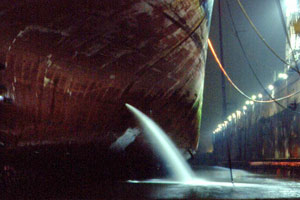
Malaria is a dangerous infectious disease which can be caught during voyages in risk areas. If it gets detected in time, it is curable. Untreated, some forms of Malaria can cause severe organ damages and even lead to death.
The Maritime Medical Service (Seeärztlicher Dienst) of the BG Verkehr updated all important information about the disease and its prevention in the new Leaflet on Malaria. It also details how to get the case of Malaria recognized as occupational disease.
In comparison to the previous version, the Malaria leaflet of the BG Verkehr contains three alterations:
- The map of areas with a high risk of Malaria transmission has been updated,
- The information that the drug Malarone can be taken over a longer period of time,
- The detailed description with photos of how to prepare a blood sample for the recognition as an occupational disease later on.
For a hardcopy of the brochure of the Leaflet on Malaria please refer to Mr. Meixner, phone +49 40 36 137-236 or e-mail: klaus.meixner@bg-verkehr.de.
Please note that the old leaflet has to be replaced at the latest for the next inspection of the medicine cabinet, in accordance with section 109 paragraph 3 of the German Maritime Labour Act).
Further information on medical equipment on board of ships can be found in our rubric "Maritime Medicine".
The planned increase of wage tax relief from 40% to 100% for the German flag has become reality: as of now shipowners do not have to pay wage tax to the tax office for their seafarers working on German-flagged merchant ships.
Basis for the change is the "Gesetz zur Änderung des Einkommenssteuergesetzes zur Erhöhung des Lohnsteuereinbehaltes in der Seeschifffahrt" (Act of the amendment of the Income Tax Act to increase wage tax relief in maritime shipping). This act also repeals the previous 183-day-regulation. Crew members do not have to be in a 183 day long employment relationship anymore for the shipowner to be able to make use of this tax benefit.
The European Commission has declared its consent to this aid on 3. May. With the publication of this resolution in the Federal Law Gazette (Bundesgesetzblatt), this new regulation will come into force.

With this act the federal government and states make good on their promise to make the German flag more competitive. The shipowners deduct the full wage tax from the wages of their seafarers, but may keep it rather than forwarding it to the tax office. This puts German shipowners on equal footing with many shipping companies abroad that do not have to pay wage tax for their seafarers.
Shipowners may utilize the full wage tax relief from the June wage payment period.
To improve the service for maritime shipping, BSH extends the customer service for the German Flag State Administration. From 1st April 2016 shipowners, seafarers, authorities and other offices have the Maritime Hotline as round-the-clock on-call service at their disposal for expert questions as well as emergencies.With this expanded service, the BSH and the Ship Safety Division increase their availability for matters concerning maritime shipping. Direct contact with the German flag is possible day and night as well as on Sundays and public holidays to answer questions regarding maritime shipping and to be able to resolve pressing matters.
Jörg Kaufmann, head of the department Maritime Shipping at BSH states: “With the Maritime Hotline we can guarantee that even after office hours advice and help can be given for all matters.”
The Maritime Hotline is available on+49-(0)40-3190-7777 from April.
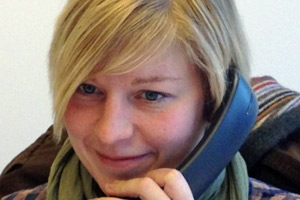
More English translations of German laws and ordinances - the German flag complies with this request by shipowners and offers more and more German legislative texts in English.
Currently, seven German ordinances are available in English:
- Safe Manning Ordinance (Schiffsbesetzungsverordnung)
- Seafarers' Competencies and Proficiencies Regulations (Seeleute-Befähigungsverordnung)
- Maritime Vocational Training Ordinance (See-Berufsausbildungsverordnung)
- Offshore Working Time Ordinance (Offshore-Arbeitszeitverordnung)
- Ordinance on the table of shipboard working arrangements and records of hours of work in maritime shipping (See-Arbeitszeitnachweisverordnung)
- Ordinance on Accommodation in Maritime Shipping (See-Unterkunftsverordnung) und
- Maritime Working Verification Ordinance (Seearbeitsüberprüfungs-Verordnung).
The portfolio of English translations will be expanded in the future.

